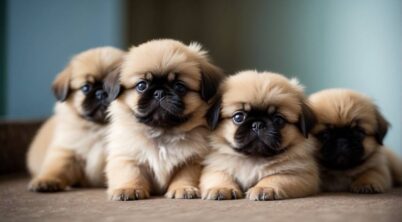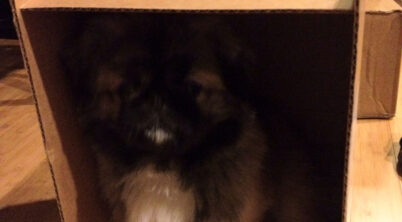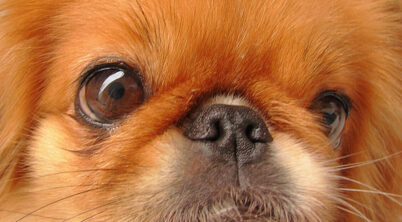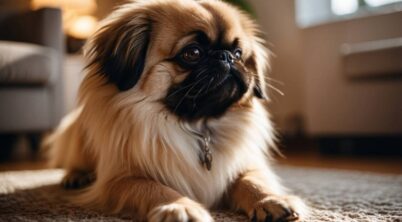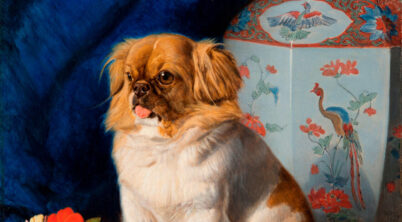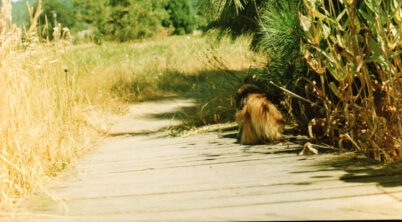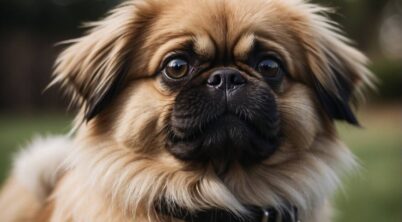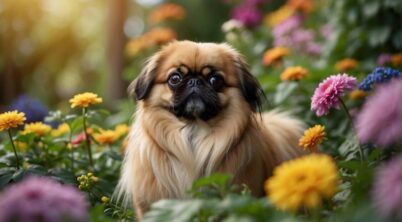The Pekingese, a dog with regal roots that trace back to ancient China, has a storied past steeped in the lap of luxury. Originating from the Imperial family, these stately pets were once confined to the Chinese ruling classes, who treasured them for their lion-like appearance—a feature that resonated with the lion’s significance in Buddhist culture. These “lion dogs” were so revered that commoners had to bow to them, and theft of a Pekingese was punishable by death. Their history with the Western world began when British troops invaded the Summer Palace during the Second Opium War in 1860, and a Pekingese named Looty was brought to Queen Victoria, marking the breed’s introduction to Europe.
Characterized by a distinctive flat face, long, flowing mane, and a confident yet serene demeanor, the Pekingese carries itself with the dignity of its prestigious lineage. Despite their small frame, they possess a self-important attitude and an undeniably courageous spirit—qualities that the American Kennel Club suggests should exemplify courage and self-esteem over delicacy. These compact toy dogs have maintained their status as cherished companions, adapting from the laps of emperors to loving modern households.
Pekingese are known for their affectionate nature and strong loyalty to their families. They flourish with attention but can also assert a protective streak when it comes to their home and loved ones. While their gait may roll and their size may be diminutive, these dogs possess a hearty constitution. Grooming, however, is not a trivial matter; a Pekingese in full show coat demands meticulous and regular grooming. Despite their inclination toward being lap dogs, early socialization is crucial to developing a well-rounded character that can engage confidently with the world beyond Beijing’s ancient walls.
Table of Contents
Pekingese Characteristics
The Pekingese is a toy dog breed known for its independent and alert nature. They exhibit a charming and dignified persona, often described as having a lion-like image due to their bold and confident appearance. Their physical structure is compact, yet the breed has a surprisingly sturdy and strong constitution.
Size and Appearance:
- Weight: Ranges typically between 7 to 14 pounds.
- Build: Compact and stocky with a heavy front and lighter hindquarters.
- Coat: Long, thick, and comes in various colors.
- Face: Distinctive flat face with large, round eyes.
Temperament:
- Social Nature: Pekingese dogs are generally friendly and affectionate, especially toward their families.
- Independence: They are known to be somewhat willful and may exhibit reserved behavior around strangers.
Behavior:
- Barking: Pekingese may bark to alert their owners, showing a protective instinct.
- Compatibility: They typically get along with older children who respect their space.
Care:
- Grooming Needs: Requires regular grooming due to their long coat. Daily brushing is recommended to prevent matting.
- Exercise: Moderate exercise suffices due to their size; however, they enjoy short walks and playtime.
The breed’s characteristics make it a popular choice for those seeking a small dog with a large personality. It’s important for potential owners to consider the Pekingese’s need for socialization and grooming when deciding if the breed is right for them.
Appearance and Size
The Pekingese breed is renowned for its distinctive appearance that reflects its noble Chinese ancestry. Notably small in size, these dogs are robust and compact, revealing a form favored by emperors as palace companions.
Coat and Color
The Pekingese sports a double coat that is long, coarse, and comes in a spectrum of colors. The outer coat is thick, imparting the breed’s characteristic “lion’s mane” around the neck and shoulders. The undercoat is soft and dense, creating insulation. The color palette ranges from black, white, cream, sable, gray, tan, red, and gold, sometimes exhibited in various blends and with unique markings.
Body Structure
Standing at heights of 6-9 inches, the Pekingese displays a stout body structure, weighing up to 14 pounds. They possess a distinct brachycephalic (flat face) feature, with a short snout that can lead to snoring. Their build is stocky and muscular, supporting a rolling gait. Despite their modest height, this breed’s body is surprisingly heavy and substantial, embodying a sense of dignity and strength.
Personality and Temperament
The Pekingese breed is known for its distinctive and complex temperament, combining regal sophistication with strong-willed independence. These dogs exhibit a blend of loyalty and affection alongside a confident and alert nature.
Behavior Traits
Loyal: Pekingese dogs are intensely loyal to their families, often forming strong, enduring bonds with their owners.
Independent and Stubborn: They possess an independent streak that can sometimes manifest as stubbornness, making consistent training important.
Alert and Watchful: With a natural inclination to be alert, Pekingese make good watchdogs, often barking to alert their owners of anything unusual.
Social Characteristics
Affectionate: They thrive on affection from their owners and can be quite loving and gentle.
Intelligent but Opinionated: Pekingese are intelligent but may have their own ideas about how things should be done, showing a regal and sophisticated demeanor.
Good-Natured but Can be Aloof: They generally have a good-natured personality, but can display aloofness or aggressiveness around strangers or other dogs if not properly socialized.
Lapdog Tendencies: They enjoy being lapdogs and will often seek out a comfortable lap to snuggle on, loving the closeness to their human companions.
Health and Lifespan
The Pekingese breed, renowned for its connection with ancient Chinese royalty, tends to have a lifespan ranging from 12 to 15 years. It is crucial for potential owners to be aware of the breed-specific health concerns impacting this lifespan and the preventative measures they can take.
Common Health Concerns
The Pekingese are predisposed to several health problems due to their distinct physical characteristics. A few of the common concerns are:
- Brachycephalic syndrome: This condition is related to their flat faces and can lead to breathing problems.
- Intervertebral disc disease: A spinal condition sometimes found in Pekingese, which can result in pain, nerve damage, or paralysis.
- Progressive retinal atrophy: A degenerative eye disorder that can lead to blindness.
- Patellar luxation: The dislocation of the kneecap that can affect mobility and comfort.
- Heart murmurs: Often detected during veterinary exams, these can signify underlying heart issues.
Care and Prevention
To mitigate health risks and promote a healthy life for a Pekingese, owners should:
- Regular Veterinary Check-ups: Early detection of issues like heart murmurs or intervertebral disc disease can help in managing the condition effectively.
- Adequate Exercise: Maintaining an adequate level of activity is important, but care should be taken to not over-exert due to potential breathing problems.
- Eye Care: Regular monitoring for signs of progressive retinal atrophy and seeking veterinary advice can prevent complications.
- Weight Management: Prevent obesity to decrease the risk of exacerbated skeletal concerns, such as patellar luxation.
- Awareness of Symptoms: Recognize early signs of breathing difficulty and seek veterinary care as part of managing brachycephalic syndrome.
Grooming and Care
The Pekingese breed demands careful attention to its grooming and care, necessitating an owner’s commitment to regular maintenance of its distinctive coat as well as a mindful approach to exercise and diet.
Grooming Needs
The Pekingese possesses a luxurious double coat, which includes a thick undercoat and a long, straight outer coat, often referred to as a “lion’s mane.” Regular brushing—at least a few times a week—is essential to prevent matting and shedding. Daily brushing may be needed during seasonal changes when the breed tends to shed more. Owners must pay special attention to the areas behind the ears, under the legs, and the abdominal region where tangles commonly form.
Bathing Bathing should occur every three to four weeks using a mild dog shampoo to keep their coat clean without stripping natural oils. It’s imperative to thoroughly dry the coat afterwards to prevent chilling or skin irritation.
| Grooming Task | Frequency |
|---|---|
| Brushing | Several times a week (daily during shedding season) |
| Bathing | Every 3-4 weeks |
Exercise and Diet
Despite their small size, Pekingese still require exercise to stay healthy, with a recommended daily short walk and playtime to cater to their energy levels. Their exercise needs are moderate and they should be guarded against overheating due to their short snouts. Prolonged or intense exercise is not recommended.
Their diet should be high-quality, proportionate to their age, and measured to maintain a healthy weight to avoid stress on their relatively short legs and potential respiratory issues. Overfeeding can lead to weight gain which is particularly problematic for this breed.
Feeding Schedule
- Puppies: Small portions 3-4 times a day.
- Adults: Two meals per day.
Positive reinforcement is effective during training and when introducing exercise routines, while socialization should be part of their regular activities to ensure they remain well-adjusted and friendly.
Breed Information and Recognition
The Pekingese is a toy dog breed revered for its historical significance and continued recognition by established kennel clubs. Notably, they are valued both as a companion dog and, historically, as lapdogs within royal circles.
Historical Significance
The Pekingese breed boasts a storied past, deeply rooted in ancient Chinese history. They were once regarded as sleeve dogs, a term denoting their role as imperial companions small enough to fit into the voluminous sleeves of Chinese royalty. The breed’s likeness to the lion—symbolic in Chinese culture—earned them great esteem, and they were often companions to nobles and even guarded sacred temples as watchdogs.
Modern Recognition
Today, the Pekingese holds a respected status among toy breeds, recognized by the American Kennel Club (AKC) and other reputable breeders. As members of the toy group, Pekingese are celebrated for their adaptability to apartment living, though potential owners should be aware of their characteristic barking which can be a byproduct of their watchdog roots. The breed’s prominence is marked by accolades in prestigious competitions, such as the Westminster Dog Show, where a Pekingese named Wasabi notably triumphed in 2021. While they exude charm as lapdogs, prospective owners are encouraged to acquire their pets from reputable breeders, ensuring the continuation of this beloved toy dog‘s lineage.

